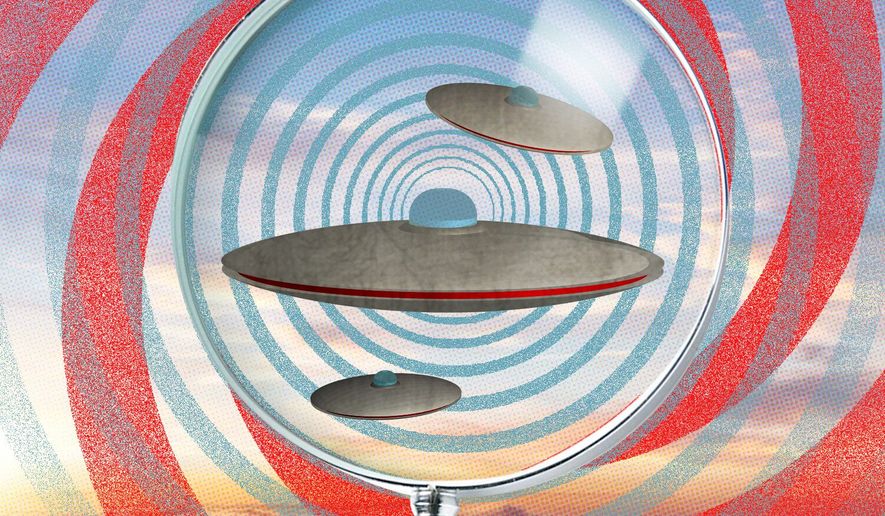OPINION:
Unidentified Flying Objects (UFOs) have moved out of the realm of tin foil hats and into the mainstream. They now merit a public Pentagon study and scrutiny by Congress.
A recent “60 Minutes” story on the subject featured gun camera footage of several aircraft moving incredibly fast while conducting maneuvers impossible even for our most advanced military aircraft. They also appeared to have stealth technology beyond the capabilities of existing U.S. systems. More disturbing, is that these craft were operating near major U.S. bases in the last decade on a recurring basis.
These objects are officially known as Unidentified Aerial Phenomena (UAP). As Sen. Marco Rubio has pointed out, any UAP operating in restricted US airspace must be considered a threat until proven otherwise. There are three potential explanations for the UAPs. Two are plausible; one, while improbable, cannot be completely ignored.
First, they may be experimental U.S. reconnaissance aircraft of such an advanced design that their very existence is in the “black” realm. Several of the participants in the 60 Minutes story claim that they have the highest levels of security clearance, and that they should have been aware of any such advanced programs. The reality is that, despite your level of clearance, you may not have a “need to know” about a given program. There is a good reason for that. Early in the nuclear era, too many scientists who were involved in nuclear weapons programs had too much knowledge of the intricate workings of the bombs. Some were closet supporters of the Soviet Union and shared that information with Moscow allowing the former USSR to become a nuclear power. If we have advanced systems far beyond currently know technology, we are right to guard it closely.
We now know that many of the UFOs observed in the western U.S. in the 1950s and ’60s, particularly around the legendary Area 51 complex, were experimental high flying and high-speed reconnaissance aircraft owned by the CIA and Air Force. In some ways, government agencies hoisted themselves on their own petards by tacitly encouraging the notion that these craft were UFOs in order to keep the real programs secret. They inadvertently fueled conspiracy theories in this manner. If the Defense Advanced Research Agency (DARPA) or any of the military services have this kind of technology, I personally do not want to know, nor should I. That said, I hope the answer to the UAP question are American in origin.
The second possibility is more ominous. If the UAP are advanced technological aircraft from a potentially hostile power probing our defenses, we have a significant military-industrial problem in trying to catch up. This would be an existential threat that would need to be addressed as seriously as the COVID-19 pandemic. For decades, Americans have assumed that we possess unassailable technological advantage in both manned and unmanned aircraft. We have made that mistake before. In the years before World War II, the United States assumed that the Japanese were so technologically inferior, that they could only produce cheap knock-offs of Western products. When the Japanese Zero nearly cleared the skies of American aircraft in the months following Pearl Harbor, Americans learned the hard way never to underestimate potential enemies; that is a cautionary tale.
The third possibility is that the UAP are of extraterrestrial origin. I personally think this is improbable — not because I discount the possibility of other intelligent life in the universe — but because I believe that any civilization having the capability of interstellar travel could do exploration and reconnaissance with undetectable micro and nano technologies. The concept of such civilizations doing “sack dances” in the airspace around major terrestrial military bases does not pass the common-sense test. If a benign alien civilization is observing us to see if we merit contact, we would likely be unaware of their presence entirely. If such technologically superior visitors were hostile we would be in a great deal of trouble.
In any case, the problem merits serious study. However, how much the results of such studies should be revealed to the public requires due diligence. This is particularly true if the results reveal the possession of advanced technology by us or our adversaries.
A prudent approach would be to form a small bipartisan panel of highly respected former senators and congressmen to advise both the president and congressional leadership as to how much information should be released to the public. People of the stature of former Sens. James Webb, Bob Smith, Harry Reid, and former House speaker Paul Ryan remain well thought of by Congress and the public. The truth may be out there, but not all of us need to know.
• Gary Anderson lectures on Alternative Analysis at the George Washington University’s Elliot School of International Affairs.




Please read our comment policy before commenting.